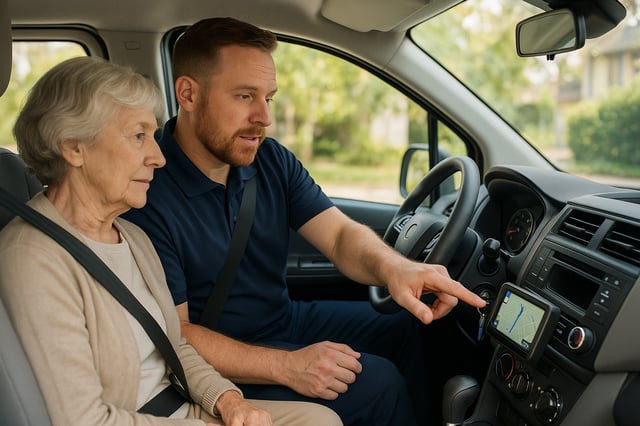

NEMT Entrepreneur provides expert insights, strategies, and resources to help non-emergency medical transportation professionals grow their businesses. Get industry-leading advice to succeed in NEMT.
Featured articles
Effective communication between drivers and dispatchers is critical in Non-Emergency Medical Transportation (NEMT). It impacts scheduling, compliance, patient safety, and overall efficiency. Poor communication can lead to delays, missed appointments, and increased costs, while clear protocols and modern tools help streamline operations.
Key Takeaways:
- Common Issues: Miscommunication about schedules, outdated technology, and lack of training are major challenges.
- Solutions: Implement clear Standard Operating Procedures (SOPs), provide regular training, and use modern dispatch software with real-time updates.
- Technology Benefits: Tools like mobile apps and GPS tracking improve coordination, reduce errors, and enhance service reliability.
- Feedback Matters: Regular feedback from staff and patients helps identify and fix communication gaps.
“Talk So Truck Dispatch Actually Listens - Tips That Work”
Setting Up Standard Communication Protocols
Clear communication protocols are the backbone of a smooth-running Non-Emergency Medical Transportation (NEMT) operation. They provide a shared framework for drivers, dispatchers, and other team members, ensuring everyone is on the same page. Without these protocols, even the most dedicated teams can face confusion, delays, and dissatisfied patients.
The success of these protocols depends on clarity and consistency. When everyone knows what to communicate, how to communicate it, and when, the entire operation flows more efficiently. These protocols also act as a safety net in high-pressure situations, ensuring critical details aren’t overlooked. Here’s how to create and implement them effectively.
Creating Standard Operating Procedures (SOPs)
SOPs should cover all routine interactions and common scenarios faced during daily operations. Key areas to address include regular check-ins, delay notifications, emergency response protocols, and documentation requirements.
- Regular check-ins: Drivers should touch base with dispatchers at specific points - starting their shift, arriving for pickups, completing transports, and ending their shift. These updates should include essential details like location, patient information (in line with HIPAA requirements), and estimated times of arrival (ETAs).
- Delay notifications: Since delays are common in NEMT, it’s crucial to have a clear process in place. Drivers must notify dispatchers of any delay exceeding 10 minutes, providing the reason and an updated ETA. This allows dispatchers to inform patients and healthcare providers promptly, possibly adjusting schedules to avoid missed appointments.
- Emergency response protocols: SOPs should outline who to contact first in various emergencies - whether it’s a medical issue, a vehicle breakdown, or an accident. Include specific contact numbers, the order of communication, and what details must be shared immediately versus what can wait.
- Documentation requirements: Accurate records are essential for compliance and operational improvement. Drivers should know what to log in real-time, such as pickup and drop-off times, incidents, mileage, and fuel use, and what can be completed later.
Additionally, SOPs should emphasize communication etiquette. This includes using professional, clear language, confirming receipt of important messages, and seeking clarification when needed. Standard phrases like "10-4" for acknowledgment or "ETA" for estimated time of arrival can help minimize misunderstandings.
Once SOPs are established, the next step is training your team to apply them consistently.
Training Drivers and Dispatchers
Protocols are only as effective as the training behind them. Thorough training ensures drivers and dispatchers not only understand the procedures but also apply them confidently in real-world situations. Key areas to focus on include professional communication, active listening, and cultural awareness.
- Professional communication: Teach drivers and dispatchers to convey information clearly and concisely. For instance, instead of saying, "Patient needs help", they should specify, "Patient requires wheelchair assistance." Similarly, "Running late" should be replaced with "15-minute delay due to traffic on I-95."
- Active listening: Dispatchers, in particular, need to manage multiple conversations while coordinating schedules. Training should emphasize techniques like repeating back key details, asking clarifying questions, and acknowledging when they need a moment to process complex information.
- Cultural awareness: NEMT services often cater to diverse populations. Drivers and dispatchers should learn to communicate respectfully, taking into account language barriers, religious practices, and varying levels of comfort with technology or medical procedures.
Role-playing exercises are an excellent way to practice these skills. Simulating real-world scenarios - like handling emergencies, managing upset patients, or communicating delays - helps build confidence and prepares staff for challenging situations.
It’s also essential to train your team on the communication tools you use, whether it’s a mobile app, two-way radio, or dispatch software. Hands-on practice in realistic scenarios ensures everyone knows not just how to use these tools, but also when and what information to share through them.
Finally, don’t stop at initial training. Ongoing training reinforces good habits and keeps staff updated on new procedures or technologies. Monthly meetings can include discussions of communication challenges and group brainstorming for solutions. You might also consider a mentorship program, pairing new hires with experienced staff to help them navigate both formal protocols and the nuances of effective communication.
Investing in well-rounded training reduces errors, improves patient satisfaction, and ensures smoother operations. When your team understands the purpose and importance of these protocols, they’re more likely to follow them consistently - even in high-stress situations.
Using Technology to Improve Communication
Modern technology has transformed how drivers and dispatchers stay connected, moving beyond basic radios and phone calls to advanced platforms that offer real-time updates and seamless coordination. With the right tools, communication gaps shrink, human errors decrease, and everyone stays on the same page throughout the day. The key is integration - bringing together tracking, messaging, and scheduling into one platform. This unified setup not only simplifies operations but also ensures things run smoothly, even during the busiest times.
Benefits of Dispatch Software and Mobile Apps
Dispatch software and mobile apps act as a direct link between dispatchers, drivers, and passengers, improving real-time coordination and cutting down on delays. By removing the guesswork, these tools help prevent missed appointments and scheduling mishaps.
Real-time GPS tracking gives dispatchers full visibility of the fleet. This means they can provide accurate ETAs and adjust plans instantly when unexpected issues arise. Such insights lead to better scheduling and improved service for passengers.
Driver apps also play a critical role by connecting drivers directly to the dispatch system. These apps replace the need for constant calls or radio check-ins. Drivers can receive live updates, check their schedules, and make adjustments as needed - all from their devices. Plus, they make it easy for drivers to send quick status updates.
Automated notifications and integrated messaging systems ensure that everyone gets instant updates about trip changes, cutting down on delays caused by manual communication.
When paired with standardized communication protocols and thorough training, these technologies boost efficiency and help deliver smoother, more dependable services.
sbb-itb-cef70f4
Getting Feedback and Making Improvements
Even the best systems need regular feedback to stay effective. Without it, small issues can quickly grow into bigger problems that hurt service quality and team morale. The most successful NEMT operations make feedback a regular part of their routine, fostering an environment where drivers and dispatchers feel comfortable sharing what’s working and what isn’t.
Feedback isn’t just about fixing problems - it’s about improving continuously. Gathering input from your team helps you identify trends and uncover training gaps. This proactive approach ensures communication keeps up with the demands of daily operations.
Setting Up Feedback Systems
Having the right channels for feedback is key to capturing insights from different perspectives. Here are a few ways to make it happen:
- Weekly meetings: Short, focused meetings provide a space for discussing communication challenges. Keep them action-oriented to address issues effectively.
- Digital surveys: Quick online surveys or feedback apps can capture real-time concerns. Keep these forms brief - just three to five questions - to encourage participation.
- Incident logs: Use these to document communication breakdowns, such as missed pickups or scheduling conflicts. Track details like the time, type of issue, and team members involved. This helps identify patterns and pinpoint whether problems are isolated or systemic.
- Anonymous suggestions: Physical or digital suggestion boxes give team members a way to share honest feedback, especially on sensitive topics like interpersonal issues or management practices.
- Passenger feedback: Complaints about long wait times or lack of updates often highlight communication gaps between drivers and dispatchers. Use this input to identify areas needing improvement.
Tracking and Improving Communication Performance
Once you’ve collected feedback, the next step is to analyze and act on it. Start by organizing the feedback into categories like response time issues, unclear instructions, technology problems, or training needs. Grouping feedback this way helps you spot recurring problems and prioritize solutions.
Monthly performance reviews should include metrics that measure communication alongside traditional indicators like on-time performance and customer satisfaction. Track things like average response times to driver requests, the number of communication-related incidents, and feedback scores from both drivers and dispatchers.
When issues are identified, pilot test solutions before rolling them out to everyone. For example, if drivers struggle with new route instructions, test alternative formats with a small group first. This lets you fine-tune changes before implementing them across the board.
Follow-up surveys are essential to measure the impact of changes. If you adjust dispatch protocols based on feedback, survey the team a few weeks later to see if the changes resolved the issues or created new ones.
Technology often plays a role in improving communication. For instance, if drivers report trouble accessing schedule updates on their devices, it might be time to evaluate your current app or consider switching to a more user-friendly option. Tools like Bambi’s AI-powered communication features can simplify messaging, automate updates, and improve integration between dispatchers and drivers.
Sometimes, feedback points to a need for training updates. If dispatchers report that drivers aren’t following communication protocols, it could mean they need a refresher course rather than disciplinary action. Similarly, if drivers struggle with dispatch codes or procedures, updating training materials can prevent future confusion.
Finally, close the loop by letting your team know how their feedback has led to changes. When people see that their input drives real improvements, they’re more likely to stay engaged in the process. Regular updates about these changes reinforce the importance of open communication and ongoing feedback.
Handling Common Communication Situations
Effective communication is at the heart of NEMT operations, especially when dealing with common challenges that can impact both patient satisfaction and operational efficiency. This section focuses on practical strategies for managing these situations, emphasizing the importance of structured and professional responses. When communication falters during critical moments, the consequences can extend beyond inconvenience, potentially affecting patient health and regulatory compliance.
Best Practices for Different Scenarios
Different situations require tailored approaches to ensure service quality remains intact, even when unexpected events arise. Below is a breakdown of key scenarios and recommended actions for both drivers and dispatchers:
| Scenario | Driver Actions | Dispatcher Actions | Timeline |
|---|---|---|---|
| Trip Delay (5-15 minutes) | Inform about the exact delay time and its cause | Log the delay reason for future analysis | Notify immediately |
| Trip Delay (15+ minutes) | Call the patient or facility with a realistic timeline | Evaluate the impact on subsequent trips | Within 5 minutes |
| Vehicle Breakdown | Take photos if safe and provide exact location details | Arrange towing and a replacement vehicle | Follow emergency protocol |
| Patient Emergency | Stay with the patient and provide location details to emergency services | Coordinate with emergency services and patient contacts | Immediate response |
| Trip Cancellation | Record the reason and circumstances of the cancellation | Adjust schedules to fill gaps with standby trips | Within 2 minutes |
| Route Changes | Confirm route details by repeating them back | Offer step-by-step directions with landmarks | Real-time communication |
These guidelines build on existing protocols, addressing real-time scenarios that demand swift and precise actions.
For patient no-shows, drivers should wait the designated time (usually 5-10 minutes), attempt to contact the patient, and document the situation. Dispatchers must verify the no-show, update billing records, and reassign the driver to optimize routing.
In cases of weather-related delays, communication every 30 minutes is crucial. Drivers should report specific hazards, such as ice or flooding, rather than general weather updates. This level of detail allows for timely route adjustments.
When dealing with facility delays at hospitals or clinics, drivers should check in every 15 minutes to provide updated wait times. Dispatchers can then adjust schedules for subsequent pickups and communicate accurate arrival times to other patients.
Staying Responsive During Unexpected Changes
Protocols and technology play a vital role in keeping communication effective when unexpected changes occur. The goal is to prioritize patient safety while minimizing disruptions.
Drivers should always provide specific delay details - for example, "delayed 20 minutes due to construction on Highway 95, new ETA 2:45 PM" - rather than vague updates. This allows dispatchers to make informed decisions about rescheduling and prioritizing appointments.
For critical appointments, like dialysis, dispatchers should assess the impact of delays immediately and notify patients as early as possible. While technology, such as automated dispatch systems, can send alerts for delays exceeding set thresholds, human judgment remains essential. For example, in medical emergencies, dispatchers may need to personally call patient families despite automated updates.
During chaotic situations, drivers can use voice-to-text features to document key details safely. This information helps dispatchers provide accurate updates and creates a record for future analysis.
To maintain communication reliability, vehicles should be equipped with multiple backup options, such as mobile phones, two-way radios, and satellite communicators for areas with poor coverage. Dispatchers should also have access to alternative contact methods, like emergency numbers and direct facility lines.
When communicating delays to patients, clarity and sensitivity are key. Drivers should avoid sharing unnecessary details about other patients. A simple explanation, such as "we’re experiencing an unexpected delay and will arrive approximately 30 minutes later than scheduled", is more effective and professional.
Escalation protocols are essential for determining when to involve supervisors. While minor delays can be handled between drivers and dispatchers, more serious incidents - like vehicle accidents, patient emergencies, or widespread disruptions - require immediate notification of management.
The most prepared teams regularly practice these scenarios through role-playing exercises and communication drills. These exercises ensure that everyone is ready to respond professionally and effectively when it matters most.
Conclusion: Key Points for Better Communication
Strong communication between drivers and dispatchers is the cornerstone of successful NEMT (Non-Emergency Medical Transportation) operations. It directly influences patient care, operational efficiency, and compliance with regulations. The strategies shared in this guide provide a solid framework to handle daily tasks and unexpected challenges alike.
Standardized procedures are the foundation of effective communication. Clear and consistent standard operating procedures (SOPs) ensure that everyone knows how to respond in various situations, from minor delays to serious emergencies. When both drivers and dispatchers operate within the same guidelines, communication becomes smoother and more dependable.
Integrating technology takes communication to the next level by simplifying processes and reducing manual tasks. Modern dispatch software and mobile apps provide real-time updates, automated alerts, and streamlined documentation. These tools keep everyone informed without overwhelming them with unnecessary details.
AI-powered tools, such as Bambi's solutions, bring even more precision to NEMT operations. By automating alerts, enabling HIPAA-compliant messaging, and tracking performance, these technologies improve coordination, enhance patient care, and boost overall efficiency.
Continuous improvement is another critical element of effective communication. Regular training and feedback sessions help teams refine their communication protocols over time. Tools like surveys, debriefs, and open dialogue channels allow teams to address potential gaps before they escalate. Building mutual trust between drivers and dispatchers encourages open communication, making it easier for team members to share important updates and collaborate effectively.
The most successful NEMT providers understand that communication is a balance between technology and human interaction. Automated systems handle routine updates efficiently, while strong personal connections ensure teams remain resilient during challenging situations. Scenario-based training and communication drills further prepare teams to handle unexpected events with professionalism and efficiency, maintaining high-quality service even under pressure.
FAQs
How do standardized communication protocols improve driver-dispatcher coordination in NEMT operations?
Standardized communication protocols play a key role in keeping drivers and dispatchers on the same page. They ensure information is exchanged clearly, consistently, and on time. The result? Fewer errors, better on-time performance, and improved vehicle efficiency - all of which contribute to a better experience for patients.
These protocols also help maintain compliance with safety standards and regulations. By promoting smoother operations, they build trust and reliability in the service provided to patients.
How can modern dispatch software and mobile apps improve communication between drivers and dispatchers?
Modern dispatch software and mobile apps simplify communication by providing real-time updates, automated alerts, and instant messaging. These features help cut down on delays and minimize misunderstandings, making daily operations run more smoothly. They also improve route accuracy and enhance overall coordination.
For NEMT providers, using advanced communication tools isn't just about efficiency - it’s about delivering better service to riders. These technologies promote transparency and enable quick problem-solving, which are key to maintaining high standards and meeting client expectations effectively.
How can regular feedback and training improve communication between drivers and dispatchers in NEMT services?
Regular feedback and continuous training play a key role in improving communication between drivers and dispatchers in NEMT services. Open feedback channels give drivers the opportunity to share their on-the-road experiences and voice any concerns. This helps dispatchers gain a clearer picture of the challenges drivers face, paving the way for better collaboration and fewer misunderstandings.
Consistent training keeps both drivers and dispatchers on the same page when it comes to best practices, policies, and the latest technology. By targeting specific areas that need improvement and encouraging teamwork, these initiatives contribute to smoother day-to-day operations, reduced conflicts, and better service for passengers.


